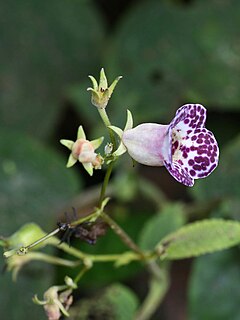
The woodland thicket rat is a species of rodent in the family Muridae. It is found in Angola, Burundi, Democratic Republic of the Congo, Kenya, Malawi, Mozambique, Rwanda, South Africa, South Sudan, Eswatini, Tanzania, Zambia, and Zimbabwe. Its natural habitats are subtropical or tropical dry forest, subtropical or tropical moist lowland forest, subtropical or tropical dry shrubland, subtropical or tropical moist shrubland, subtropical or tropical high-altitude shrubland, subtropical or tropical dry lowland grassland, arable land, pastureland, and urban areas.
The gray-tailed narrow-headed rat is a species of rodent in the family Muridae. It is found only in Ethiopia. Its natural habitats are subtropical or tropical moist montane forests, subtropical or tropical high-altitude shrubland, and subtropical or tropical high-altitude grassland. It is threatened by habitat loss.

The long-billed partridge is a species of bird in the family Phasianidae.
Atelopus lynchi is a species of toad in the family Bufonidae. It is endemic to Ecuador. Its natural habitats are subtropical or tropical moist lowland forests, subtropical or tropical moist montane forests, and rivers. It is threatened by habitat loss.

Scinax quinquefasciatus is a species of frog in the family Hylidae. It is found in Colombia and Ecuador. Its natural habitats are subtropical or tropical dry forests, subtropical or tropical moist lowland forests, subtropical or tropical moist shrubland, intermittent freshwater marshes, plantations, rural gardens, urban areas, heavily degraded former forest, ponds, and canals and ditches.
Kurixalus odontotarsus is a species of frog in the family Rhacophoridae. It is found in southern China, Vietnam, Laos, and possibly Myanmar. Its natural habitats are subtropical or tropical moist lowland forests, subtropical or tropical moist montane forests, subtropical or tropical moist shrubland, intermittent freshwater marshes, heavily degraded former forest, and canals and ditches. It is threatened by habitat loss.

The Chuuk monarch, or Truk monarch is a species of bird in the family Monarchidae. It is monotypic within the genus Metabolus. It is endemic to the island of Chuuk in Micronesia.

The Bale shrew is a species of mammal in the family Soricidae.

Jackson's shrew is a species of mammal in the family Soricidae. It is found in Burundi, Democratic Republic of the Congo, Kenya, Rwanda, South Sudan, and Uganda. Its natural habitats are subtropical or tropical moist lowland forest, subtropical or tropical moist montane forest, and heavily degraded former forest.

MacMillan's shrew is a species of mammal in the family Soricidae.

Thalia's shrew is a species of mammal in the family Soricidae. It is endemic to Ethiopia. The mammal's natural habitats are subtropical or tropical moist montane forests, moist savanna, and subtropical or tropical high-altitude grassland.

The large-eared free-tailed bat is a species of bat in the family Molossidae found in Angola, Central African Republic, Democratic Republic of the Congo, Ivory Coast, Djibouti, Ethiopia, Ghana, Kenya, Malawi, Rwanda, South Africa, Tanzania, Uganda, Yemen, Zambia, and Zimbabwe, and possibly Madagascar. Its natural habitats are subtropical or tropical dry forest, subtropical or tropical moist lowland forest, subtropical or tropical moist montane forest, dry savanna, arable land, and plantations. It is threatened by habitat loss.
Burmeistera sodiroana is a species of plant in the family Campanulaceae. It is endemic to Ecuador. Its natural habitat is subtropical or tropical moist montane forests. It is threatened by habitat loss.
Gasteranthus carinatus is a species of plant in the family Gesneriaceae. It is endemic to Ecuador. Its natural habitats are subtropical or tropical moist lowland forests and subtropical or tropical moist montane forests.

Gasteranthus tenellus is a species of plant in the family Gesneriaceae. It is endemic to Ecuador. Its natural habitats are subtropical or tropical moist lowland forests and subtropical or tropical moist montane forests.
Greigia sodiroana is a species of plant in the family Bromeliaceae. It is endemic to Ecuador. Its natural habitats are subtropical or tropical moist montane forests and subtropical or tropical high-altitude shrubland. It is threatened by habitat loss.
Monopyle ecuadorensis is a species of plant in the family Gesneriaceae. It is endemic to Ecuador. Its natural habitats are subtropical or tropical moist lowland forests and subtropical or tropical moist montane forests.

Monopyle paniculata is a species of plant in the family Gesneriaceae. It is endemic to Ecuador. Its natural habitat is subtropical or tropical moist montane forests at altitudes of 500-1000m.
Monopyle stenoloba is a species of plant in the family Gesneriaceae. It is endemic to Ecuador. Its natural habitat is subtropical or tropical moist lowland forests.
Puya sodiroana is a species of plant in the family Bromeliaceae. It is endemic to Ecuador. Its natural habitat is subtropical or tropical moist montane forests. It is threatened by habitat loss.











